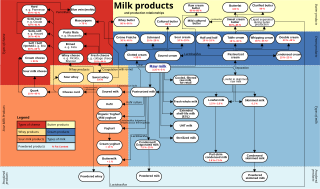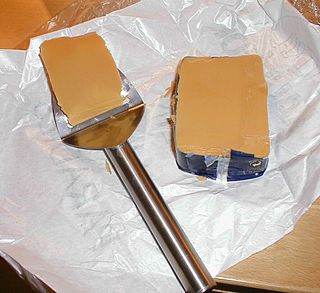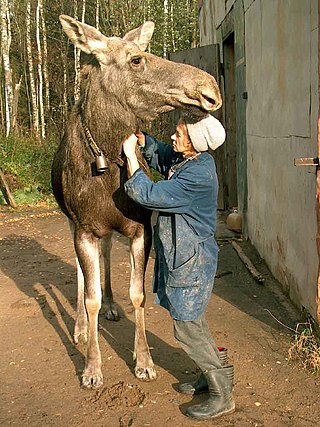| Moose cheese | |
|---|---|
| Country of origin | Sweden |
| Region | Bjurholm Municipality |
| Town | Bjurholm, at the Älgens Hus farm |
| Source of milk | Moose |
| Fat content | 12%[ citation needed ] |
| Protein content | 12%[ citation needed ] |
Moose cheese is cheese created from moose milk. Varieties of moose cheese are produced in Sweden by Christer and Ulla Johansson at their location called "Moose House"[ citation needed ] or "Elk House". [1] Three varieties of moose cheese are produced. [1]
The Elk House (Älgens Hus) farm in Bjurholm, Sweden, run by Christer and Ulla Johansson, is believed to be the world's only producer of moose cheese. It has three milk-producing moose, [2] whose milk yields roughly 300 kilograms of cheese per year; the cheese sells for about US$1,000 per kilogram [3] (approximately US$455 per pound).
Three varieties of cheese are produced: a rind-style, a blue and a feta-style.
The cheese is served at the Älgens Hus' restaurant, [1] located in Sweden. [4]
Moose Cheese also produced by GamEat [5] from Russia by cheese maker Alexander Fursin

Cheddar cheese is a natural cheese that is relatively hard, off-white, and sometimes sharp-tasting. Cheddar originates from the English village of Cheddar in Somerset.

Dairy products or milk products, also known as lacticinia, are food products made from milk. The most common dairy animals are cow, water buffalo, nanny goat, and ewe. Dairy products include common grocery store food items in the Western world such as yogurt, cheese, milk and butter. A facility that produces dairy products is known as a dairy. Dairy products are consumed worldwide to varying degrees. Some people avoid some or all dairy products either because of lactose intolerance, veganism, or other health reasons or beliefs.

The moose or elk is the only species in the genus Alces. The moose is the tallest and second-largest land mammal in North America, only falling short of the American buffalo in terms of mass. It is the largest and heaviest extant species of deer. Most adult male moose have distinctive broad, palmate antlers; most other members of the deer family have antlers with a dendritic ("twig-like") configuration. Moose typically inhabit boreal forests and temperate broadleaf and mixed forests of the Northern Hemisphere in temperate to subarctic climates. Hunting and other human activities have caused a reduction in the size of the moose's range over time. It has been reintroduced to some of its former habitats. Currently, most moose occur in Canada, Alaska, New England, New York State, Fennoscandia, the Baltic states, Poland, Kazakhstan, and Russia.

Brie is a soft cow's-milk cheese named after Brie, the French region from which it originated. It is pale in color with a slight grayish tinge under a rind of white mould. The rind is typically eaten, with its flavor depending largely upon the ingredients used and its manufacturing environment. It is similar to Camembert, which is native to a different region of France. Brie typically contains between 60% and 75% butterfat, slightly higher than Camembert.

Roquefort is a sheep milk blue cheese from Southern France. Though similar cheeses are produced elsewhere, EU law dictates that only those cheeses aged in the natural Combalou caves of Roquefort-sur-Soulzon may bear the name Roquefort, as it is a recognised geographical indication, and has a protected designation of origin.

A pancake is a flat cake, often thin and round, prepared from a starch-based batter that may contain eggs, milk and butter and cooked on a hot surface such as a griddle or frying pan, often frying with oil or butter. It is a type of batter bread. Archaeological evidence suggests that pancakes were probably eaten in prehistoric societies.

Finnish cuisine is notable for generally combining traditional country fare and haute cuisine with contemporary continental-style cooking. Fish and meat play a prominent role in traditional Finnish dishes in some parts of the country, while the dishes elsewhere have traditionally included various vegetables and mushrooms. Evacuees from Karelia contributed to foods in other parts of Finland in the aftermath of the Continuation War.

Brunost is a common Norwegian name for mysost, a family of cheese-related foods made with whey, milk, and/or cream. The term is often used to refer to Fløtemysost or Gudbrandsdalsost, which are the most popular varieties. Brunost is primarily produced in Norway and is popular there, and has spread to South Korea. It is regarded as one of the country's most iconic foodstuffs, and is considered an important part of Norwegian gastronomical and cultural identity and heritage.

Stilton is an English cheese, produced in two varieties: Blue, which has Penicillium roqueforti added to generate a characteristic smell and taste, and White, which does not. Both have been granted the status of a protected designation of origin (PDO) by the European Commission, requiring that only such cheese produced in the three counties of Derbyshire, Leicestershire and Nottinghamshire may be called Stilton. The cheese takes its name from the village of Stilton, now in Cambridgeshire, where it has long been sold.

Jarlsberg is a mild cheese made from cow's milk, with large, regular eyes, originating from Jarlsberg, Norway. It is produced in Norway, as well as in Ireland and the US state of Ohio, licensed from Norwegian dairy producers. It is classified as a Swiss-type cheese.

Bjurholm is a locality and seat of Bjurholm Municipality in Västerbotten County, Sweden with 968 inhabitants in 2010. It is the second smallest municipal seat in Sweden and the seat of the second to least populated municipality in the country. A tourist attraction in the region is Älgens Hus. Here visitors can see a tame moose and find out more about elks.
Norwegian cuisine in its traditional form is based largely on the raw materials readily available in Norway and its mountains, wilderness, and coast. It differs in many respects from continental cuisine through the stronger focus on game and fish. Many of the traditional dishes are the result of using conserved materials, necessary because of the long winters.

Fontina is a cow's milk cheese, first produced in Italy. Over time, production of Fontina has spread worldwide, including to the United States, Denmark, Sweden, Canada, France and Argentina.

Cheese is a dairy product produced in wide ranges of flavors, textures, and forms by coagulation of the milk protein casein. It comprises proteins and fat from milk. During production, milk is usually acidified and either the enzymes of rennet or bacterial enzymes with similar activity are added to cause the casein to coagulate. The solid curds are then separated from the liquid whey and pressed into finished cheese. Some cheeses have aromatic molds on the rind, the outer layer, or throughout.

Moose milk, also known as elk milk, refers to milk produced by moose. Though it is most commonly consumed by moose calves, its production has also been commercialised in Russia, Sweden and Canada.

There are many different types of cheese. Cheeses can be grouped or classified according to criteria such as length of fermentation, texture, methods of production, fat content, animal milk, and country or region of origin. The method most commonly and traditionally used is based on moisture content, which is then further narrowed down by fat content and curing or ripening methods. The criteria may either be used singly or in combination, with no single method being universally used.

Prison food is the term for meals served to prisoners while incarcerated in correctional institutions. While some prisons prepare their own food, many use staff from on-site catering companies. Some prisons support the dietary requirements of specific religions, as well as vegetarianism. Prisoners will typically receive a series of standard meals per day from the prison, but in many prisons they can supplement their diets by purchasing additional foods, including snacks and desserts, at the prison commissary with money earned from working in the prison or sent by family and friends.
Pule cheese or magareći sir, is a Serbian cheese made from 60% Balkan donkey milk and 40% goat's milk.

Pig milk is milk from pigs, and is typically consumed by piglets. It is similar in composition to cow's milk, though higher in fat and more watery. Pig milk is seldom obtained for human uses and is not considered to be a viable agricultural product. Several attempts have been made to produce pig milk cheese, some of which have been successful.